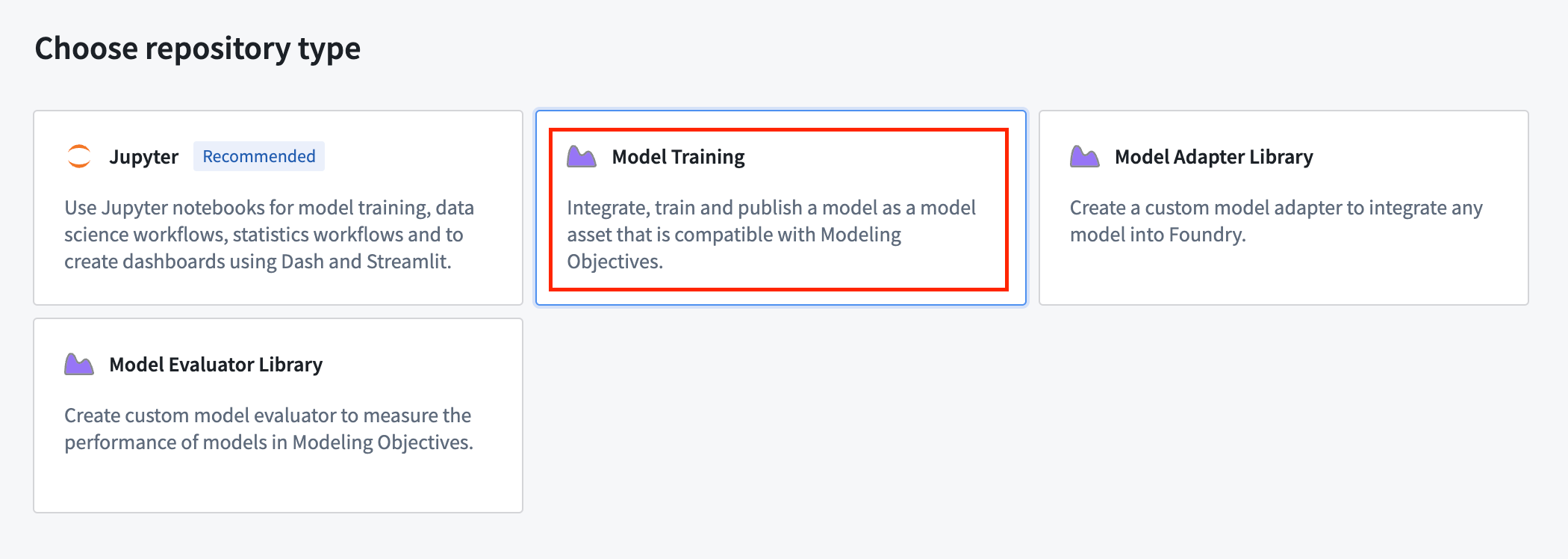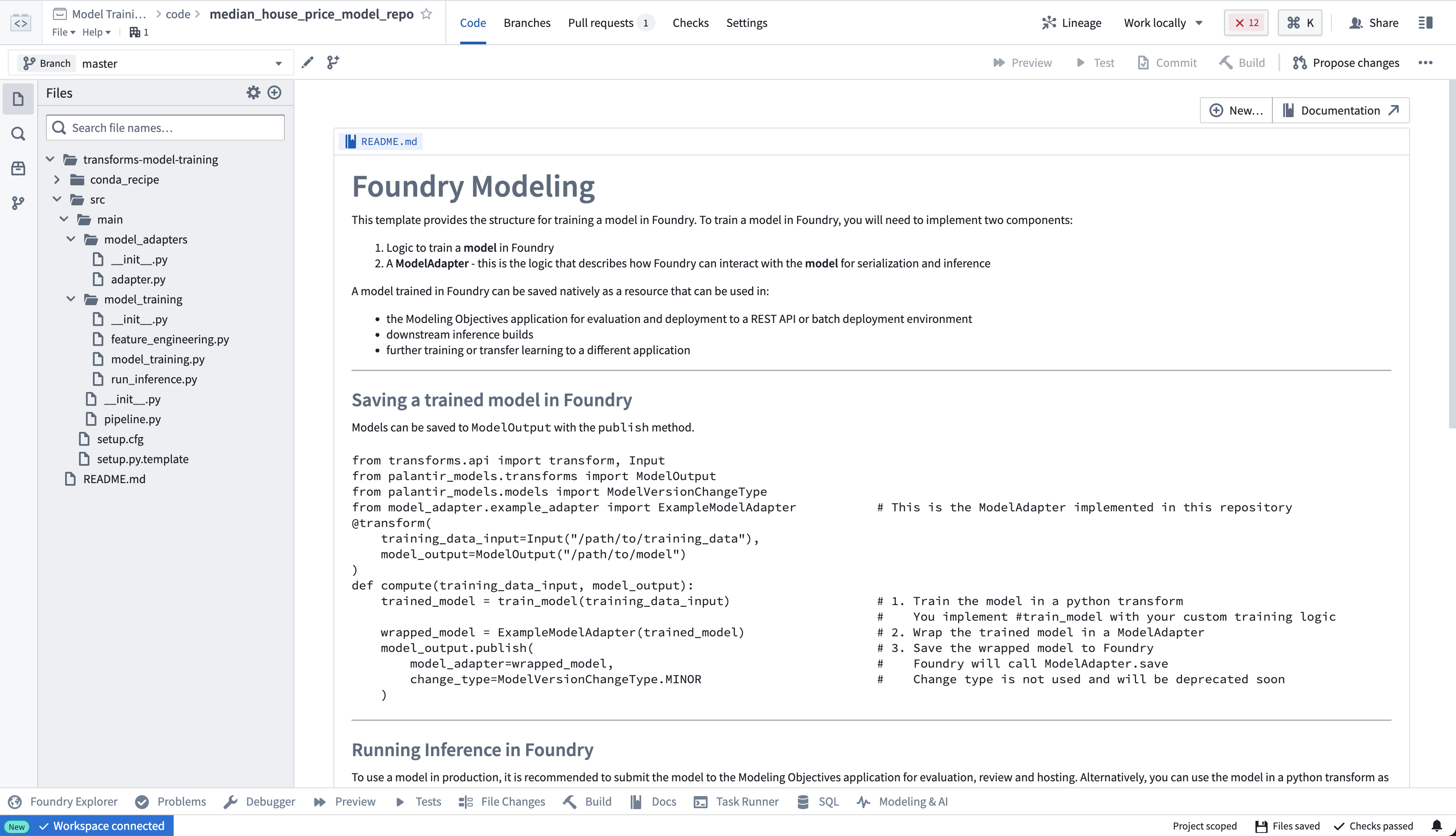Migration instructions: foundry_ml [planned deprecation] to palantir_models
This page provides best practices and instructions for migrating a model built with foundry_ml to the palantir_models framework. To start, we share some guidance to consider, before providing an example migration. In the example, we provide code for building a model in Code Repositories using foundry_ml, and demonstrate how to rewrite this code using palantir_models.
Best practices
In the following section, we list guidance on how the migration can be performed and what considerations to take.
Migration methods
You can build the migrated model in the following ways:
- Build the model in a new code repository or Jupyter® code workspace, or;
- Build the model by editing an existing code repository.
Both methods have advantages and which is best depend on your particular situation, but there are a few things to keep in mind:
- If the initial model was built in Code Workbooks, you will need to build it in a new code repository or Jupyter® code workspace as the latter two products support
palantir_models. - It is usually easier to use a model for inference in the code repository or code workspace that it was built in, since importing a model into another repository or workspace requires importing its Python dependencies and may result in environment conflicts.
To understand how to use a new code repository to build your model, review the following example.
How to migrate a modeling repository in place
To keep your existing modeling repository and migrate it from foundry_ml to palantir_models in place, follow these steps:
- Comment out or remove any code referencing
foundry_ml. - Remove the
foundry_mllibrary from theLibrariessidebar. - Upgrade the repository to the latest configuration.
- Upgrade Python to a major version of 3.10 of higher by selecting Recommended in the Run with and Build with menus, or by editing the
conda_recipe/meta.yamlfile directly and updating the existing Python dependency topython >=3.11.*(or3.10.*, if required) in both thebuildandrunblocks. Note that Python 3.9 will be deprecated in October 2025 as part of a dedicated migration campaign. - Install the recommended version of
palantir_modelsfrom theLibrariessidebar. Do not do this by editingmeta.yamldirectly as it will not import the required backing repositories.
If using an existing repository of the Pipeline type rather than Model training or Model adapter library to create your Model adapter, you will not benefit from the latest modeling features unless you upgrade your repository. This upgrade action is necessary for your model to support direct deployments.
Migration of a model built with foundry_ml in Code Repositories
The following is an example migration migration from foundry_ml to palantir_models in Code Repositories.
The following snippet demonstrates a scikit-learn linear regression model authored to use foundry_ml, which we will migrate to palantir_models:
Copied!1 2 3 4 5 6 7 8 9 10 11 12 13 14 15 16 17 18 19 20 21 22 23 24 25 26 27 28from transforms.api import transform, Input, Output from foundry_ml import Model, Stage from sklearn.linear_model import LinearRegression from sklearn.pipeline import Pipeline from sklearn.preprocessing import StandardScaler @transform( training_data_input=Input("<YOUR_PROJECT_PATH>/data/housing_train_data"), model_output=Output("<YOUR_PROJECT_PATH>/models/linear_regression_foundry_ml"), ) def create_model(training_data_input, model_output): training_df = training_data_input.pandas() numeric_features = ['median_income', 'housing_median_age', 'total_rooms'] pipeline = Pipeline([ ("scaler", StandardScaler()), ("regressor", LinearRegression())]) X_train = training_df[numeric_features] y_train = training_df['median_house_value'] pipeline.fit(X_train, y_train) model = Model(Stage(pipeline["scaler"], output_column_name="features"), Stage(pipeline["regressor"])) model.save(model_output)
To migrate the above code from foundry_ml to palantir_models, follow the steps outlined below.
Step 1: Open a new code repository with the model training template
The Palantir platform provides a templated repository for machine learning called the Model training template. To access it in Code Repositories, first select Models when asked What are you building?:

Select Model Training as the repository type:

The model training template contains the example structure that we will adapt for this tutorial. You can expand the files on the left side to see an example project:

Step 2: Author a model adapter
Model adapters provide a standard interface for all models in Foundry. This standard interface ensures that all models can be used immediately in production applications. The Palantir platform will handle the infrastructure to load the model and its Python dependencies, interface with it, and expose its API.
To enable this, you must create an instance of a ModelAdapter class to act as this communication layer.
There are three functions to implement:
- Model save and load: In order to reuse your model, you need to define how your model should be saved and loaded. Palantir provides many default methods of serialization (saving), and in more complex cases you can implement custom serialization logic.
- API: Defines the model's API and tells the Palantir platform what type of input data your model requires.
- Predict: Called by the Palantir platform to provide data to your model. This is where you can pass input data to the model and generate inferences (predictions).
Open the model_adapters/adapter.py file and author the model adapter:
Copied!1 2 3 4 5 6 7 8 9 10 11 12 13 14 15 16 17 18 19 20 21 22 23 24 25import palantir_models as pm from palantir_models.serializers import DillSerializer class SklearnRegressionAdapter(pm.ModelAdapter): @pm.auto_serialize( model=DillSerializer() ) def __init__(self, model): self.model = model @classmethod def api(cls): columns = [ ('median_income', float), ('housing_median_age', float), ('total_rooms', float) ] return {'df_in': pm.Pandas(columns=columns)}, \ {'df_out': pm.Pandas(columns=columns + [('prediction', float)])} def predict(self, df_in): df_in['prediction'] = self.model.predict(df_in[['median_income', 'housing_median_age', 'total_rooms']]) return df_in
For more information about model adapter logic, refer to author a model adapter.
Step 3: Write the model training logic
In the example below, the train_model function contains an unchanged example of the training logic from foundry_ml. The compute function wraps the model with the model adapter, and publishes the model.
Copied!1 2 3 4 5 6 7 8 9 10 11 12 13 14 15 16 17 18 19 20 21 22 23 24 25 26 27 28 29 30 31 32 33 34 35 36 37 38 39 40 41 42 43 44 45 46 47 48 49from transforms.api import transform, Input, lightweight from palantir_models.transforms import ModelOutput from main.model_adapters.adapter import SklearnRegressionAdapter from sklearn.linear_model import LinearRegression from sklearn.pipeline import Pipeline from sklearn.preprocessing import StandardScaler def train_model(training_df): """Training logic is unchanged from the original foundry_ml example.""" numeric_features = ['median_income', 'housing_median_age', 'total_rooms'] pipeline = Pipeline([ ("scaler", StandardScaler()), ("regressor", LinearRegression())] ) X_train = training_df[numeric_features] y_train = training_df['median_house_value'] pipeline.fit(X_train, y_train) return pipeline # Use the lightweight decorator unless your model natively supports Spark inputs # (i.e. uses Spark ML). Without it, the input data will first be loaded in Spark # and will require conversion to Pandas for use in the model, which is a slow and # memory-intensive operation. # Lightweight requires the foundry-transforms-lib-python package # and for the repository to be up-to-date. # https://palantir.com/docs/foundry/code-repositories/repository-upgrades @lightweight() @transform( training_data_input=Input("<YOUR_PROJECT_PATH>/data/housing_train_data"), model_output=ModelOutput("<YOUR_PROJECT_PATH>/models/linear_regression_model"), ) def compute(training_data_input, model_output): training_df = training_data_input.pandas() # train model model = train_model(training_df) # wrap model with model adapter foundry_model = SklearnRegressionAdapter(model) # publish the model model_output.publish(model_adapter=foundry_model)
Open the model_training/model_training.py file in your repository and author the compute function for your model. Copy your model's machine learning logic into the train_model function. Update paths to correctly point to the training dataset and model. Select Build at the top right to run the code.
Step 4: Write the model inference logic
Open the model_training/run_inference.py file in your repository and author the model inference logic. Update paths to correctly point to the model and test dataset. Select Build at the top right to run the code.
To run a model within a transform repository in which the model was not defined, set use_sidecar = True in ModelInput. This will automatically import the model adapter and its dependencies while running them in a separate environment to prevent dependency conflicts. use_sidecar is unavailable for Lightweight transforms. Review the ModelInput class reference for more details.
If use_sidecar is not set to True, the model adapter and its dependencies must be imported into or defined within the current code repository.
Copied!1 2 3 4 5 6 7 8 9 10 11 12 13 14 15 16from transforms.api import transform, Input, Output, lightweight from palantir_models.transforms import ModelInput # Lightweight requires the foundry-transforms-lib-python package # and for the repository to be up-to-date. # https://palantir.com/docs/foundry/code-repositories/repository-upgrades @lightweight() @transform( testing_data_input=Input("<YOUR_PROJECT_PATH>/data/housing_test_data"), model_input=ModelInput("<YOUR_PROJECT_PATH>/models/linear_regression_model_asset"), predictions_output=Output("<YOUR_PROJECT_PATH>/data/housing_testing_data_inferences") ) def compute(testing_data_input, model_input, predictions_output): inference_outputs = model_input.transform(testing_data_input) predictions_output.write_pandas(inference_outputs.df_out)
Following these steps above will complete the migration of your existing foundry_ml model in Code Repositories to palantir_models.
Migrating a model using MetricSets
We recommend replacing MetricSets with experiments where possible. However, while experiments now support image metrics, note they do not yet support chart metrics, contrary to MetricSets. While MetricSets will not appear on the model page for a model built with palantir_models, it is still possible to write MetricSets against a model and view the metrics in Modeling Objectives.
To do so, author your model in Code Repositories and add the foundry_ml_metrics library to your environment. Here is an example of how to use a MetricSet in conjunction with palantir_models:
Copied!1 2 3 4 5 6 7 8 9 10 11 12 13 14 15 16 17 18 19 20 21 22 23 24 25 26import uuid from transforms.api import transform, Input, Output from palantir_models.transforms import ModelInput from foundry_ml_metrics import MetricSet # add foundry_ml_metrics to your environment @transform( evaluation_data_input=Input("path_to_input"), model_input=ModelInput("path_to_model"), metric_set_output=Output("path_to_output"), ) def compute(training_data_input, model_input, metric_set_output): metric_set = MetricSet( # Pass the "hash" part of the model version identifier, for example, given # ri.models.main.model-version.6c0f17a8-ad73-46a4-b86e-8d0a13327ef2, # only pass 6c0f17a8-ad73-46a4-b86e-8d0a13327ef2. model=uuid.UUID( # The model_version_rid property is only available on the ModelInput class # for versions of palantir_models greater or equal to 0.1602.0. model_input.model_version_rid.replace("ri.models.main.model-version.", "") ), input_data=evaluation_data_input ) metric_set.add(name='Accuracy', value=0.8) metric_set.add(name='F1', value=0.95) metric_set.save(metric_set_output)
Next, configure the evaluation_data_input dataset as an evaluation dataset in Modeling Objectives' evaluation configuration. The metrics will then appear under that dataset in Modeling Objectives' evaluation view.